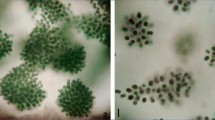Abstract
Flavobacterium lutescens has been observed to constitute a major segment of the aerobic, heterotrophic bacterial populations in nonpolluted aquatic systems. It is present in lesser numbers in the presence of municipal sewage and higher concentrations of organic wastes. In laboratory tests, in water from nonpolluted systems, this species became the predominant bacterial type following thermal addition. When temperature was increased in water from polluted sources,F. lutescens became a major component of the bacterial populations. In the laboratory, the numbers ofEscherichia coli andStreptococcus faecalis were observed to decrease in proportion to the increase inF. lutescens after thermal addition. Similar results were observed when water from three aquatic systems of differing nutrient content was tested. A greater amount of organic material present in the water reduced the predominance ofF. lutescens. These results indicate that, without use of chemical additives, this method may be useful for restoration of natural aquatic bacterial populations and reduction of undesirable microbial populations in water supplies.
Similar content being viewed by others
References
Davis, E. M., and Gloyna, E. F. 1970. Bactericidal effects of algae on organisms. F. W. P. C. A., Tech. Rept.
Ferebee, R. N. 1972. The effects of selected herbicides on bacterial populations in an aquatic environment. Ph.D. Dissertation. Department of Microbiology, Clemson University, Clemson, S.C.
Geldreich, E. E. 1970. Applying bacteriological parameters to recreational water quality.J. Amer. W. W. A. 62: 113–120.
Guthrie, R. K. 1968. Bacterial cycles and water quality.S. W. Water Works J. 50: 54.
Guthrie, R. K., D. S. Cherry, and R. N. Ferebee. 1974. A comparison of thermal loading effects on bacterial populations in polluted and non-polluted aquatic systems.Water Res. 8: 143–148.
Hendricks, C. W., and S. M. Morrison. 1967. Multiplication and growth of selected enteric bacteria in clear mountain stream water.Water Res. 1: 567–576.
Joyce, G, and Weiser, H. H. 1967. Survival of enteroviruses and bacteriophage in farm pond waters.J. Amer. W. W. A. 59: 491–501.
Potter, L. F. 1964. Planktonic and benthic bacteria of lakes and ponds.In: Principles and Applications in Aquatic Microbiology. New York: Wiley, New York. pp. 148–166.
Van Donsel, D. J., Geldreich, E. E., and Clarke, N. A. 1967. Seasonal variations of indicator bacteria in soil and their contribution to storm water pollution.Appl. Microbiol. 15: 1362–1370.
Author information
Authors and Affiliations
Rights and permissions
About this article
Cite this article
Cherry, D.S., Guthrie, R.K. Effects ofFlavobacterium lutescens growth on populations ofEscherichia coli andStreptococcus faecalis in water following thermal loading. Microb Ecol 2, 186–193 (1975). https://doi.org/10.1007/BF02010438
Issue Date:
DOI: https://doi.org/10.1007/BF02010438




